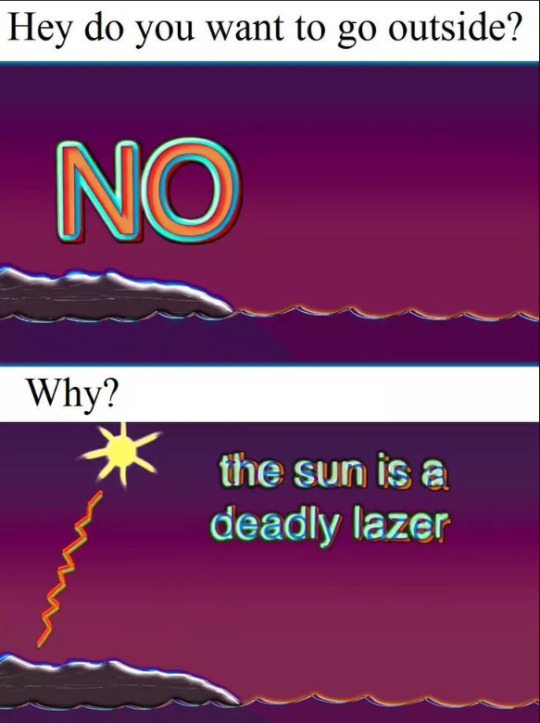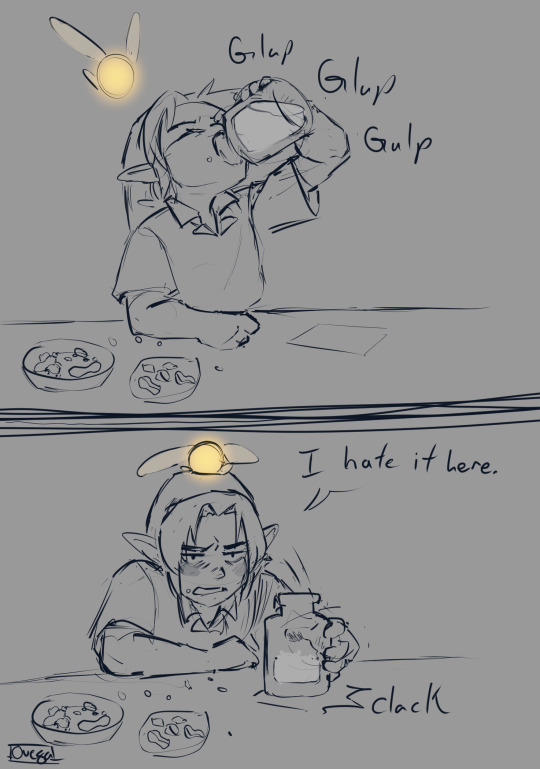24|They/It/He/Void/Xe | Klaus. 🔋🔋🔋 insta: @k_asofspades you can buy me a coffee https://ko-fi.com/asofspades
Last active 60 minutes ago
Don't wanna be here? Send us removal request.
Text
i don’t know how to explain to you people that no matter what a country’s government is like i do not and will not support the US indiscriminately bombing that country’s civilians and i don’t know why that’s a controversial take tbh
42K notes
·
View notes
Text
The Evangelion illustration is progressing alright, I did the color today, still have the final line art and details left and I still haven't decided if I'm going to do a black background or leave it like it is
Here she is

I was scared shitless when I started colouring it because the markers spread a bit on this paper (but the colours look so good tho), luckily they didn't spread much and it'll be fine when I do the final line art
#neon genesis fanart#neon genesis rei#neon genesis evangelion#rei ayanami#evangelion fanart#evangelion rei#nge rei#nge fanart#rei ayanami fanart#small artists#comission#art commisions#trafitional art
9 notes
·
View notes
Text
Some people are so chronically online it's insane, I genuinely just read a comment somewhere, I'm pretty sure it was tiktok, about the fact that they feel weird shipping Togame and Choji because, and I quote, "Choji is probably shota bait", as a reply to someone saying that they're both 17 so it kind of makes more sense to ship those two than Togame and Sakura, because Togame is 17 going on 18 and Sakura is 15 going on 16, like, gods forbid a 17 year old acts outwardly "childish" even though we've been shown he's actually not that childish in other aspects, gods forbid a dude is just hyperactive and energetic. Like, I think this is one of the most chronically online takes I've read about a ship in a while.
Like, is it that difficult to just say "I don't really like the ship but it's okay", like, me personally I don't ship togasaku, and it might be a bit because I think teens do have big maturity gaps, and maybe yes 15 and 17 is only a 2 year difference but I still think at those ages the gap is more notable than say maybe 25 and 27, but I'm not about to tell people to not ship them because I'm aware it really is just a me thing.
19 notes
·
View notes
Text
The Evangelion illustration is progressing slowly because it's really hot where I live so not only is my blood pressure low af, but my mobile overheats if I record for too long and I want to make a drawing video for this one so I have to take long breaks
Anyways, here she is so far

#nge fanart#nge rei#neon genesis fanart#neon genesis rei#neon genesis evangelion#evangelion manga#evangelion rei#evangelion fanart#rei ayanami
3 notes
·
View notes
Text
Chat, I'm working on an Evangelion illustration inspired by the collector's edition cover
I did the sketch yesterday and I was about to get started on the base line art but here you go the sketch

It's blue lead so it might be a bit difficult to see properly, definitely better than yellow and pink lead tho
I'm going to be honest, I'm not exactly a big NGE fan in fact I have barely read it I just know the main plot points, I'm interested in reading it fully tho, I just really like the art style.
#neon genesis evangelion#neon genesis rei#neon genesis fanart#evangelion fanart#evangelion rei#rei ayanami#nge#nge rei#nge fanart#evangelion manga
3 notes
·
View notes
Text
I'm not really uploading my year-round bday character challenge here but today's Dazai's bday so I'm making an exception and bringing you the little guy I drew for the challenge

I struggled to find a panel of him I hadn't drawn before, because the internet always shows me the same 20 images for some reason, I had to dive deep to get to this little bastard.
24 notes
·
View notes
Text
Someone who shares my idea that child trafficking could be a thing in Suo's past
hi. this is my first post here so pls be gentle LMAO.
WARNING: THIS POST CONTAINS ABSURD LEVELS OF DELULU, UNVERIFIED LORE-BENDING, AND PSYCHOLOGICAL THEORIZING THAT CAME FROM ME STARING TOO LONG AT SUO’S SMILE.
YOU'VE BEEN WARNED.
I am not okay and neither are you if you keep reading.😂✨HAHAHAHHAHA YES. THIS IS WILD. I’M JUST BEING WILD HERE.
No I will not calm down.
Anyway.
I’ve been absolutely consumed by this whole suo hayato mystery and i can’t shut up about it anymore. and honestly?? this theory's built from scattered bits i’ve seen from other brilliant minds here (i’ll try to track down sources later to credit properly if u want to be tagged dm me 🙏), so shoutout to everyone who's already whispered about "is he even Japanese fr???" and "what if he has actual trauma?"
here’s my personal rabbit hole.
aka: what if Suo Hayato was trafficked as a child, escaped, and ended up in Furin?
BACKSTORY THEORY (pt 1):
He’s not originally Japanese.
He was likely born in China, or somewhere else in East/Southeast Asia. He either:
never knew his parents,
or was taken from them extremely young.
In a lot of trafficking routes across East Asia (yes I pulled a few academic papers on this don't look at me), there's a real pattern of undocumented children being moved into rural ports, held in isolated labor compounds, or sold into abusive “families” or criminal networks. These kids are stripped of language, name, even identity. Some never learn who they were.
I think Suo was one of them.
But one day, something happened.
A fire? An accident? He got away. Barely.
He was injured, starving, probably still very young.
Until he met the Master.
THE MASTER — A PILLAR FIGURE
The Master isn’t just a martial arts teacher. I think he’s someone who knew exactly what Suo was.
He saw through the trauma. Saw through the fake name, the silence, the fear.
In some areas, martial arts masters take in orphans or abused kids—especially in small communities where the system isn’t reliable. I imagine he had other students—Suo calls them “brothers”—and for the first time, Suo had a life where he was allowed to exist without being used.
He trains.
He cooks.
He smiles.
He starts becoming Suo Hayato.
But that peace was always borrowed time.
THE RETURN OF THE PAST — AND THE NIGHT OF THE AMBUSH
Somehow… the traffickers find him again.
And this time, they don’t snatch him back right away.
No—they send a message.
An attack on the dojo.
Violent. Calculated. Terrifying.
Some of the brothers are killed.
Others taken.
The Master? Likely captured—or worse.
And Suo? Told to run.
I think it was the Master who screamed at him to go.
Or maybe Suo ran on instinct.
Either way—he lost everything that night.
And that’s when he came to Japan.
WHY FURIN? WHY HERE? WHY NOW?
Here’s the part I haven’t seen people talk about enough:
Why Furin?
Why go to the worst possible school full of delinquents and gangs and violence?
BECAUSE THAT’S WHERE HE CAN *DISAPPEAR*.
In Furin, everyone has a past.
Everyone fights.
No one asks.
He could blend in. Be useful again.
Protect himself.
Never be vulnerable.
It’s the perfect camouflage.
BEHAVIORAL EVIDENCE — “A TRAUMA SURVIVOR’S MOVEMENTS”
This is where I speak as someone who's studied trauma responses, and worked around clinical psych communities. (no i'm not licensed. yes i do spiral-research trauma as comfort.)
The way Suo:
smiles too much,
covers his ears in chaos,
refuses to fight unless necessary,
but when he does… it’s surgical.
Those are learned trauma adaptations.
They are not quirks.
They are coping systems for someone who had their autonomy stripped.
He is always performing safety. For others. For himself.
Even when no one’s looking.
---------
I’ll probably write a follow-up about how this affects the group, how Sakura fits in (and why a Suo vs Sakura fight would absolutely destroy both of them), but for now—
this is my hill.
and I will cry on it.
If you read this whole thing ily. If you wanna cry w me about this pls do. If u have similar theories or references SEND. THEM. TO. ME.
13 notes
·
View notes
Text
In praise of good martial forms
One thing I alluded to earlier is that Suo has really, really good martial forms. As someone who dabbled with martial arts in various stages of my life, these details jumps out. Of course, any martial artist worth their salt must have good forms, unconventional style or not (as Suo described the forms he learned as a "jumble of mixed martial arts"). Wind Breaker is one of the best choreographed manga I have seen, so these details are very much worth analyzing :P
Table of contents:
Martial arts start with good forms
Suo v. Oobiki: Is Discipline Rigidity or Fluidity?
Foundational Grounded-ness: Defense as Offense
Circularity; Yin and Yang
Suo on the Offensive: no_fist.megamind?
I will first go over the basics -- how the choreography demonstrates Suo's solid skills, which segue into Suo v. Oobiki's debate about "discipline" (spoiler: Suo wins because he has better forms, i.e. better discipline), then moving on to make more observations about his styles— particularly the circularity and how the narrative is restraining Suo from using his fist to attack.
Martial arts start with good forms
As an introduction, I will note that Suo always sits and stands very properly, with his back straight and his posture supported by his hands behind his back.
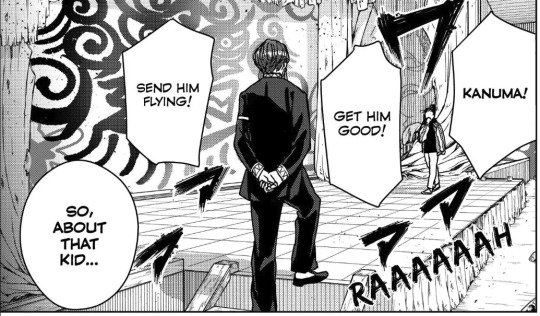
Notice also that while Sakura casually leans back against his chair, slumping backward, and Nirei "cowers" -- leaning forward -- Suo sits straight-backed like the epitome of a polite young man :3c

This is another fun contrast between Suo and most other delinquents in the story— in an environment emphasizing rebellion, freedom, and a bit of teenage arrogance mixed in, sparking all sorts of wild and flamboyant self-expressions (dyed hair, undercut, piercings, etc.), Suo alone stands with a very traditional, conservative, and almost a prudent sensibility, in both his clothings and behaviors. Had he not don his Furin jacket, would anyone believe that this gentleman is a delinquent?
That is to say, Suo's trainings are baked into his bones, to the way he holds and moves himself, most likely to even his speech. Good forms from the beginning to end. Suo likely has practiced martial arts for a good while.
The thing that makes me notice how good his form is is from his fist placement in the Kanuma fight:
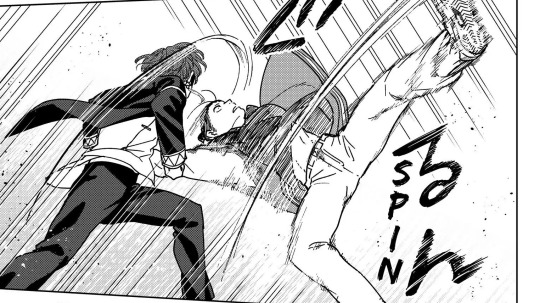
First, note that Suo's right fist is in the ready position by his hip, ready to hit. It's small, but surprisingly easy to forget when you are starting out. It's somewhat about being ready to punch at anytime (even though we never see Suo actually punching anyone), but more about the discipline of always being ready for your next move.
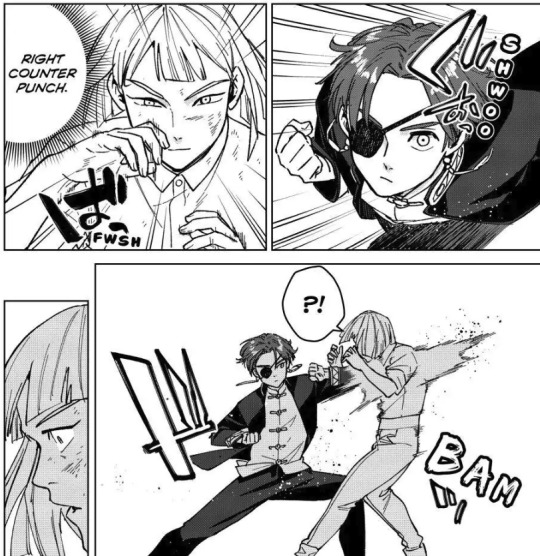
Similarly, the fist is there during the Oobiki fight. Note that Suo was able to surprise Oobiki and get a hit in because the ready-to-go fist exists as a camouflage, distracting the opponent from his other arm (out of frame— out of Oobiki's visual field). Having the fist there is an excellent basic form, and it allows Suo multiple options of attack.
Let's transition to legwork. One of the most important thing in martial arts is stances. Generally, the deeper your stance is, the lower your center of gravity, hence the more stability you have. This is, of course, at the cost of mobility, which is achievable with narrower, higher stances. An exercise at the advanced (masters') level of karate is to stand in kiba-dachi, the basic horse stance (first thing you'll ever learn) continuously for an hour or more. That's how strong your legs have to be. And practice staying in proper stances is how you hone it. Having a strong, solid stance is essential for balance and power,
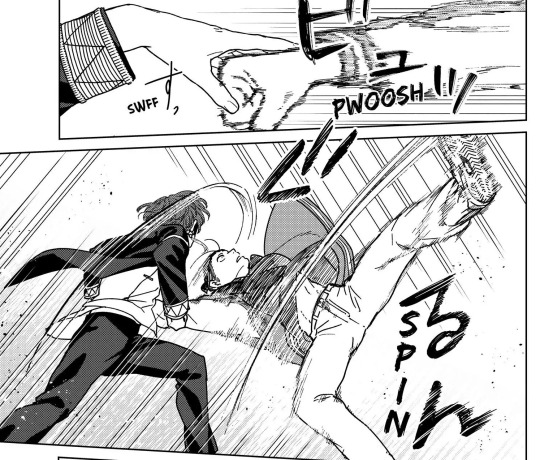
Notice the solid, deep (low) stance— and how much power is behind it as Suo very gently seize Kanuma's fist and flips him. We can see the difference in speed (and thus input power) by the blur in both frames.
Again and again, Suo does a lot of "flipping people over" like this (I'm sure there is a proper term for it, in what I assume is Aikido, but that's a martial discipline I haven't flirted with lol). I will labor the point of Suo's moves being primarily circular later, but just to demonstrate the power behind his seemingly-effortless moves:

Note the stance— and the engaged legs muscles
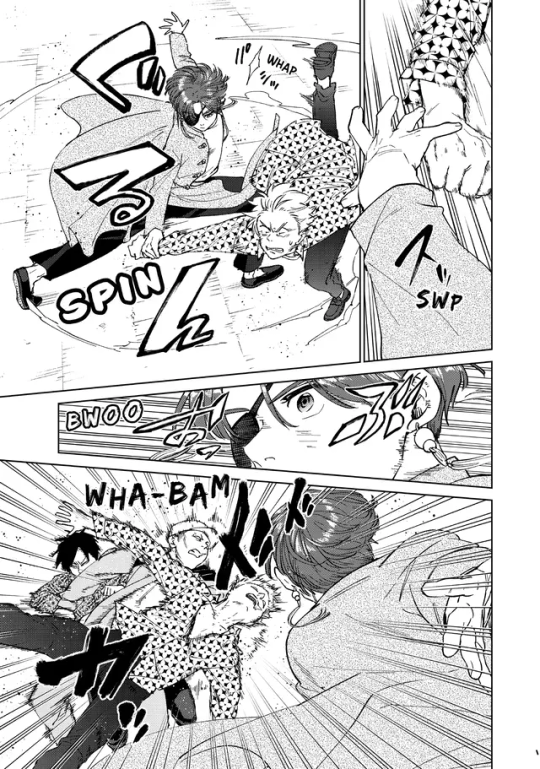
Same here— the deep stance provides a tremendous amount of power required to fling a grown man and knock out two more people. Note again the difference in speed/input momentum (top right panel).
Doing mixed martial arts doesn't means that every move is a hodge-podge of everything. Suo's starting stance is a very basic/common starting form in kungfu:
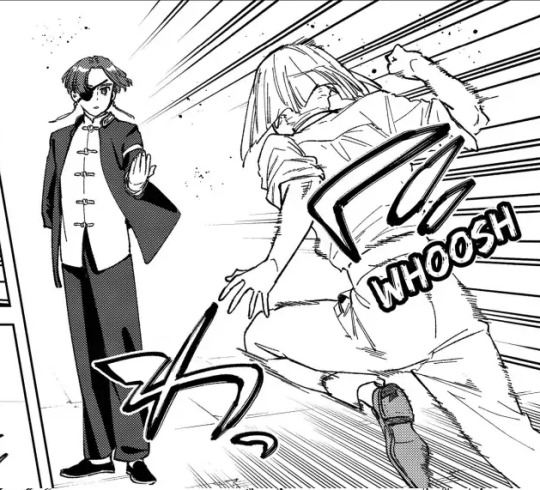
As a side note, visually this starting form is very representative of Suo as a character/fighter :P He doesn't start (seemingly) looking for a fight; his stance is neutral, relaxed; one hand is inviting the opponent into his space. However, when we look closer, his feet are position such that he is ready to lunge forward (front-facing leg) and a fist is hidden behind his back, also ready to pounce.
It is a basic stance because it is good, and great when done right. If there is one (1) single thing you get from all the ramblings I do, let it be that Suo has very good basics. From his resting stance, fist placement, low stances, to kick— everything is solid.
This brings us to the "debate" between Suo and Oobiki about what "discipline" means.
Discipline: Rigidity or Fluidity?
Suo v. Oobiki is, ultimately, a fight about their philosophy regarding "discipline". (In this manner, we can say that Suo participated in at least one conversation, lol. But more on this later in Crisis of Contact or The Failure of Language (coming soon. at some point.) perhaps.) Firstly, Oobiki brought up discipline with the context of punishment for bad behaviors:
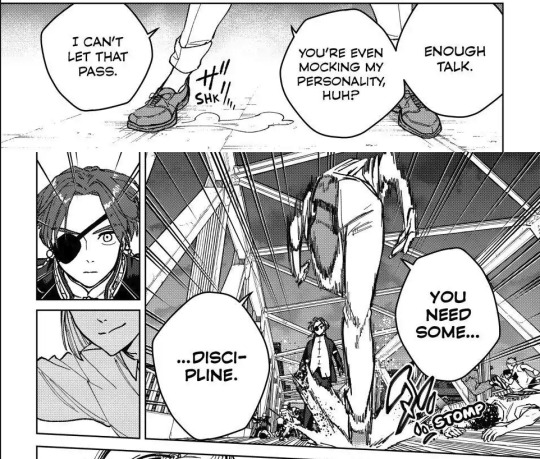
Which suggests that a (rigid) social code was violated here— which is that Suo, the underclassmen, had insulted his superior (in age and school-year). Discipline, here, is a violent mean to "bend" someone back to the appropriate behavior; or, perhaps, discipline means the rigid code of appropriate behaviors itself. Regardless, we get the sense here that "discipline" is rigid, meant to be followed to the letter, and even somewhat hierarchical: the elder enforces discipline onto the younger, not the other way around.
Ironically, this rigidity and hierarchy of discipline is what Oobiki forsook in the first place when he gave up competitive gymnastics:

Rigid routine, rigid rules;

The hierarchy of ranking and rigid scoring system;
And yet, old habits die hard. The brutality of competition and gymnastics is engrained into Oobiki's conception of discipline, and what it means to be, yourself, disciplined, or to discipline somebody else: beating the same stringent routines and rules until submission.
Afterwards, Suo relays a very different view — another definition altogether — of the word:

(Yeehaw! The first visual of Suo's master--- the same narrative role as Akari, yet so much further away...)
Discipline here is not a rigid code of rules or behavior, but rather the transmission of knowledge. This may be due to localization (can somebody please supply me with the Japanese version), but notice that Oobiki uses "discipline" as a noun, while Suo uses it as a verb. One is a thing that you have; the other is an action you impart upon someone else. Already, we see the rigidity of an object without care for whom it affects, versus an action that involves two people at the minimum (the teacher and the student) and widens the possibility of what could be taught. Martial arts is a discipline; so is calligraphy, for example, or tea ceremony, or life philosophy, or math, or science, or literature, etc.
Discipline, to Suo (relayed to him by his Master, by the quote) is a living, mobile thing, means to share knowledge without forcing it upon somebody. You can try to train or teach someone; it doesn't mean they will learn it that exact way, or they may modify your teachings to their needs. Suo is already innovating upon the discipline passed down to him by teaching Nirei to protect himself and fight back at once

It's a living thing in the same sense that humanity is a living thing, as culture and knowledge get passed down and modified generations by generations. It's quite generative, to employ a pun here. It's more philosophical and metaphysical than the concrete, object-like "discipline" that Oobiki wants to impart, or force upon, others.
How do these two views of "discipline" duke it out? By fighting, of course! And, I will argue that Suo wins because he has the better discipline, narratively speaking. Of course, it's nearly impossible for two definitions of the word to duke it out— this is why we have stories and narratives :D The key observation I want to make is that Suo has the more solid and proper forms.
I noted earlier that Suo was able to get a hit into Oobiki with his elbow because of his good ready stance with the fist. The more demonstrative example, I think, is in this sequence here, which immediately follows the aforementioned example:

Oobiki begins with a gymnastic-inspired cartwheel, using one leg to attack and hook Suo's arm down. Note that the force is concentrated on Suo's wrist. With his momentum, Oobiki's arms push upward to complete the cartwheel, and, theoretically, slam Suo's body down by his wrist (a very tiny fraction of Suo's body mass— which is proportional momentum). That's cool and all, but I think Oobiki makes a grave mistake next…

... of attacking with his other leg instead of landing. He expects Suo's whole body to go down with his wrist (which, again, very small fraction of body mass— Suo is a lot stronger physically than Oobiki expected). If that is the case, then Oobiki gets the point. However, I think, giving yourself zero point of contact on the ground — your form and stance not being grounded at all — is a risky gamble. You risk standing on nothing and having no foundation beneath to push you on. While you are falling mid-air, your opponent easily get a grasp on you, and, supplying some (seemingly) minimal amount of force, turns gravity against you. Again, no foundation, nothing solid to land on.
This is, also, the last significant movement in their choreography before the winner is decided. This ending is signified by Oobiki saying, "I can't read you at all..." before the narrative naturally descend to the conclusion of their fight with Suo as the winner. Oobiki's "encore" is merely the last desperate swipe in a conversation already closed.
Foundational Grounded-ness; Defense as Offense
Another observation: throughout the Oobiki fight, most of Suo's stances are low, deep stances, which emphasizes stability and grounded-ness. We see these in the previous examples— in the one immediately above, Suo's stance is so "deep" that he is kneeling on the ground: very stable (which also necessitates no small amount of core strength, mind you) in contrast to Oobiki's ungrounded-ness.

Here, Suo starts from a neutral, high stance, then steps out and down to move his opponent down along with his own center of gravity
Next, a very impressive (holy crap I can't properly express how fucking insane of a move that is) swing: from a low (kicking) stance, which provides the normal force necessary to push, and over


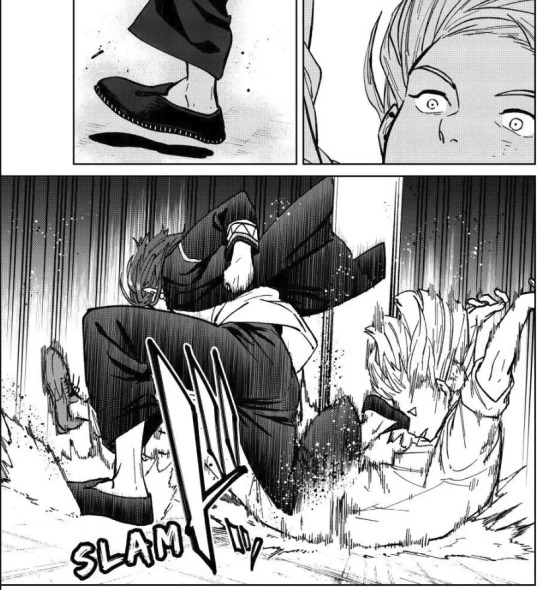
To a solid, whole foot (HEEL FIRST! THIS IS VERY IMPORTANT-- note the angle where the heel is closer to the ground) and a forceful slam down.
While Suo adeptly utilizes high, middle, and low stances, I want to point out that in this fight, all of his move begins from a low stance. Narratively, Suo is focusing on stability, grounded-ness (purpose-wise, Furin's job is to hold their ground, too), and defense — which is his specialty. Suo rarely initialize attacks as offense; here, he relies on the same grounded-ness of his defensive practice as offense. You have heard "the best defense is offense" before, now, welcome to "the best offense is defense" :P.
Combing through the manga, I am struck with how solid Suo's stances are, which I'm sure I have more than adequately emphasized by now. He is agile, mobile, and responsive, yes, but he agilely steps into a sturdy defensive stance in every fight, as demonstrated above in the Kiryuu introductory fight as well as in Roppo Ichiza.

I think this does say something about Suo as a character; just as Sakura's agility, adaptability, creativity, and ferocity says about his, or Tsugeura's high-spirited, principled (even if seemingly odd) virtues being supported by his muscular sturdiness— emphasize the simplicity of pure force, or, Sugishita's long-armed, forceful, but single-trajectory attacks says about his single-minded determination. It doesn't have to be anything too deep lest we step too close into Backstory Speculations territory (though I would not blame us for that, seeing that that is the #1 mystery right now, lol). But, to me, there seems to be an interesting contrast between Suo's image as a lighthearted, blithe, socially-adaptable child and his principled and grounded stances, which are primarily employed to protect or defend someone else.
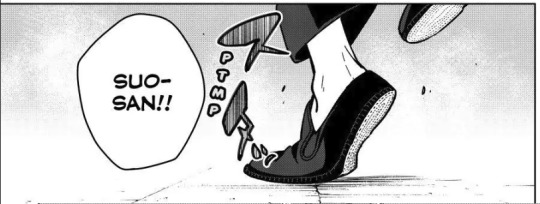
(Suo's return to the group post-Oobiki is blithe and lightfooted. At this moment, his return is more to a social effect, reconnecting with the rest of the class before the fight resume. Note that, in contrast to his earlier heel-first landing, toe-first landing is used for very light landing— a spirit of windless calm, as I love to say these days. His first impact is this lightness — relieving Nirei from his post, signifying a victory, like a balm upon the toiling soldiers.)
There is, still, a hidden sternness and practicality underneath such a light and humorous character. We caught glimpses of it: Suo who, on the first day of class, "fact-and-logic"'ed Sakura and Sugishita into resolving their conflicts:
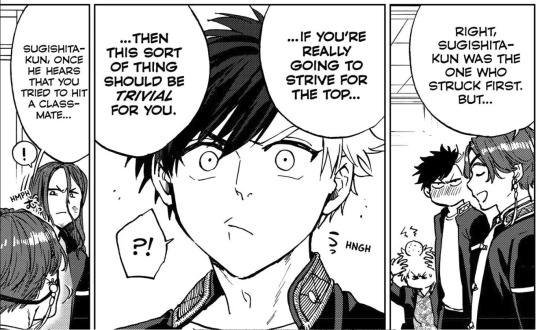
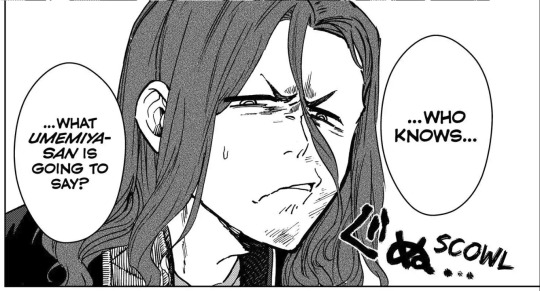
Suo who represents the foundational philosophy of fighting as a group to Sakura:

Suo is also teaching Nirei the foundation of fighting, etc. etc.
These roles fit perfectly into his motif as a "teacher" in the narrative, conveniently also as the narrative mouthpiece: I discussed in another analysis Suo's role as the one delivering "conclusive remarks" — the final deliverer of message to Sakura's journey. Just like his conception of discipline as "passing down teachings" — passing down something fundamental, grounding, upon which new innovations can be made — Suo provides the elementary, foundational "bricks" to the story, upon which Nirei, Sakura, the audience, and whomever else he will teach next, can build up their unique substances. It all starts with a good basics— that’s the thing that struck me with Suo’s fighting styles: it’s graceful and simple, based on strong and solid foundational skills.
Circularity; Yin and Yang
By now, it's clear that Suo's fighting motif is primarily circular: he twists and flips his opponents both parallel to and perpendicular to the plane of his body
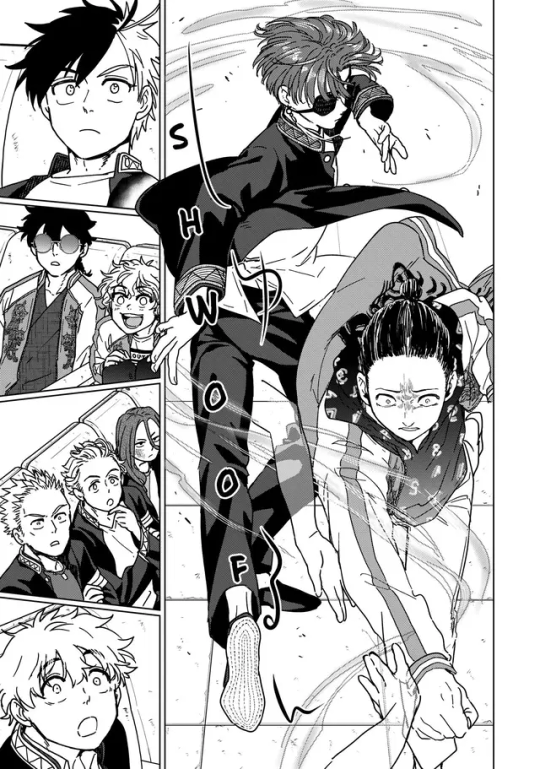
@darkersolstice and I briefly discussed this point earlier, here, where they insightfully compare Suo to the eye of a hurricane. Inspired by this, I remarked that the philosophical basis of Suo's style is something to the effect of "A steadfast heart amidst the ever-turbulent circumstances" (In Vietnamese, "Tâm bất biến giữa dòng đời vạn biến"). As the calm in the eye of the storm — the central, unmoving axis of rotation — Suo controls himself and the vortex of life such that they all pass by him. He sees and acknowledges the turbulence; but he remains unperturbed and untouched by them.
There is a nuance between what I argue here versus what I argued by Suo's evasiveness, in that it is not the fighting style that is the evasive one, but Suo is. The evasiveness — the "letting life flows by" physical philosophy — is just one of the many possible motivator for his evasion. The bulk of Suo's dodging, I think now, is social rather than physical; the physical aspect just further enforces the motif. (Or, I may argue, the physical aspect may hints towards a deeper motivation for the habitual deflection, without it being the main culprit of the evading act.)
Coming back to the circularity itself; the perfect circle has been symbolically important, throughout many culture, as a symbol of perfection and completeness. The Aristotelian view of the universe was that of a series of enclosing sphere, because circles — and spheres — are perfect. In Chinese philosophy, the same ideal is reflected in yin and yang
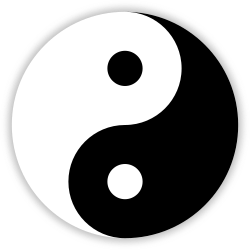
There is light in darkness, darkness in light, as circular force and motion rotate in the universe. This is the total encapsulation of everything. Suo's circular form, where he controls the sum total of his force and the opponent's momentum to his advantage, symbolize this philosophical totality. By Suo's association with a heavily Chinese motif, this could be the intended basis of his form.
Suo on the Offensive? no_fist.megamind?
Another thing that is apparent is that Suo has yet to (actually) attack with his fist; both time, against Kanuma or KEEL, he was thwarted from doing so:

Both time, Suo going for the punch was considered an excessive use of force— explicitly so in the KEEL's case, where it was considered the wrong and overly-aggressive choice. There, it also marked a break from his serene and mature characterization.
Suo does attack— but it is always with his legs, palms, or elbow (in the Oobiki fight).


Never the fist. Why?
I, to be honest, still have to ponder more what this means in relation to the rest of his defensive, circular (yin-yang), and deflective (utilizing the opponent's momentum) fighting style. An oath of non-violence, perhaps?— an oath to respond to your environment, to defend as the need arise, to seek not violence but repel it? These are compelling statements. Why kicks and push, but not fist? Perhaps there is an "excuse" of repelling and deflecting in kicking away, pushing away that does not exist in punch in, punch at, punch through. With its various prepositions, punching is rarely away, but always offensive, violating, stepping inside in a sense. Suo's discipline seems to be that of pacifism or at least, minimal violence. Violence cannot touch him, and he cannot exude violence with the discipline he was taught— handed down to? constrained in?
There are still so many interesting thoughts to extrapolate on, so many narrative trajectories wide open for Suo (and his backstory) to take— but that shall be the story for another day.
93 notes
·
View notes
Text
Chat, stop panicking, neither Suo's name nor his surname mean anything close to traitor, I don't know who started that rumour.
His surname, Suo, corresponds to sappanwood or redbud, which is usually tied to elegance and renewal. At most its Chinese origin means "thick rope" or "chain".
His name, Hayato, corresponds to a peregrine falcon and means things along the lines of "fast/brave person" and "swift tiger", so basically someone who's swift in his movements
I genuinely don't know where the traitor thing came from.
At most the Chinese meaning of his surname might indicate his family has a tight leash on him wether there's something true to the mafia family allegations or it's just a regular toxic family situation or leftover trauma from childhood, and his actual name is just a reflection of his fighting and personality, because he's also swift in the way he handles and redirects conversations.
WHAT DO YOU MEAN SUO MEANS TRAITOR??? WHAT DO YOU MEAN MY GLORIOUS KING SUO MIGHT BE A TRAITOR BECAUSE TRAITORS DON'T GET MUCH BACKSTORY UNTIL THEY'RE FOUND OUT AS TRAITORS!?!?!? WHAT DO YOU MEAN BY THAT HOE???
it's the reiner and bugatti situation all over again bro 💔
nii-san I'm on yo ass hoe 🫵
61 notes
·
View notes
Text
No because you're telling me he's a Makochi local and has likely lived there his whole life but nobody in Furin (except maybe Tsugeura, or at least that's implied) had ever crossed paths with him, that's just plain weird.
isn’t it so menacing that people know “about” suo instead of seen him… like hiiragi and them were like yeah no idk who that is but I’ve heard his name like he’s the Black Death or something im cryinggg
67 notes
·
View notes
Text
I'm working on a drawing for OOT 3Ds anniversary!!!
Here's how it's going!

So far I only have her, I've been thinking of adding the kokiri crest and her sage medallion as background pieces and that would be it
2 notes
·
View notes
Text
That's how I feel when I see how underdeveloped my personal style is in comparison to what I usually paint, which is recreations of already existing art😅
writers and artists will go "this isn't good enough." my brother in christ, you're creating something new out of nothing and expressing yourself creatively. your productivity and unrealistic standards of perfection do not define you or the worth of your art. you're doing great.
66K notes
·
View notes

